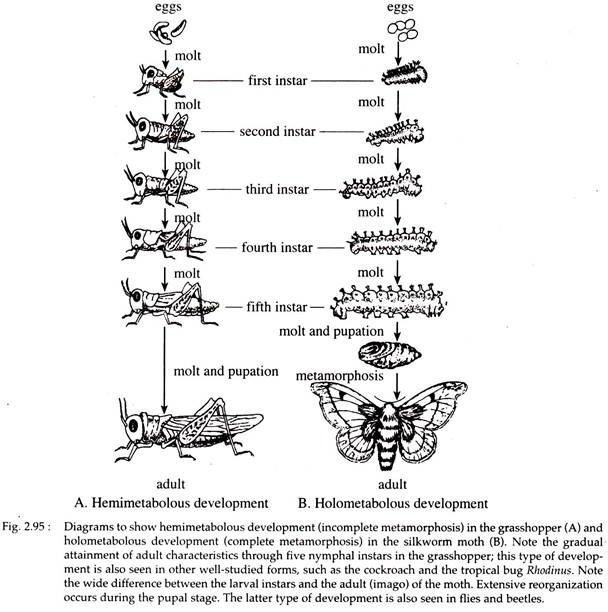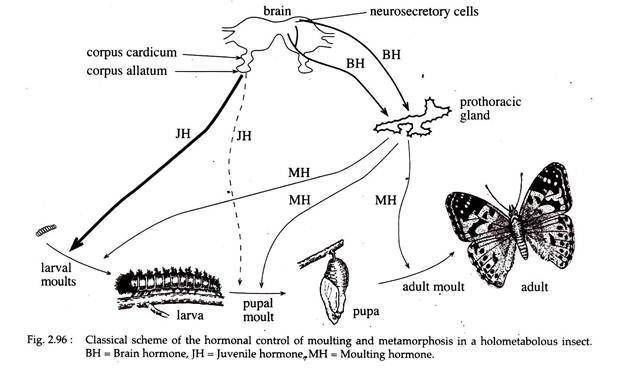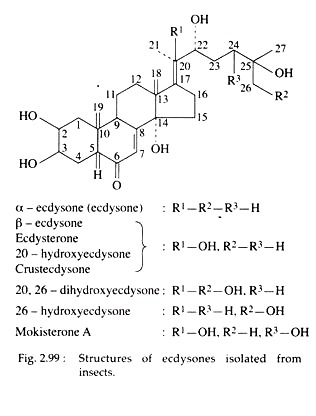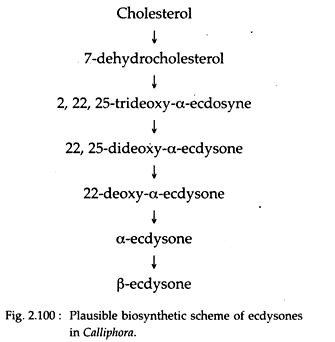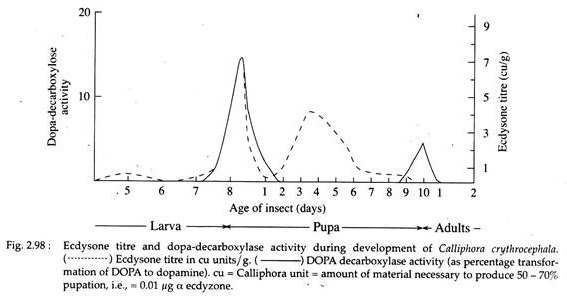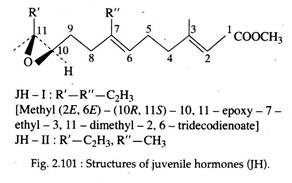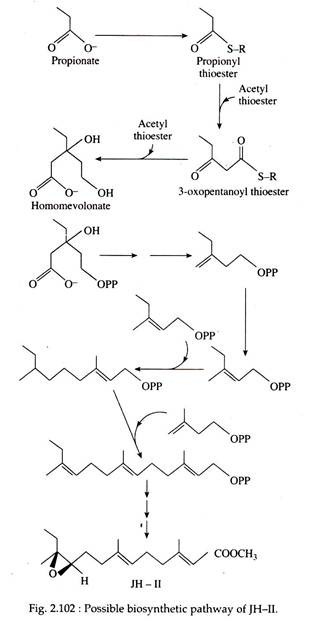In this article we will discuss about the Growth and Metamorphosis in Insects:- 1. Definition of Metamorphosis in Insect 2. Different Types of Insect Metamorphosis 3. Endocrine Control of Moulting 4. Co-ordinated Action of Hormones 5. Characteristics of Moulting Hormone (MH) 6. Characteristics of Juvenile Hormone (JH).
Contents:
- Definition of Metamorphosis in Insect
- Different Types of Insect Metamorphosis
- Endocrine Control of Moulting in Insects
- Co-ordinated Action of Hormones during Metamorphosis in Insects
- Characteristics of Moulting Hormone (MH) in Insects
- Characteristics of Juvenile Hormone (JH) in Insects
1. Definition of Metamorphosis in Insect:
The general body covering (integument) in insect forms the exoskeleton. This exoskeleton is only capable of limited expansion. Therefore, growth in these animals is intimately associated with moulting.
ADVERTISEMENTS:
The moulting is the process of resorption of some of the old cuticle and the development of new cuticle and is triggered by a steroid called ecdysone. The intervals between the moults are known as ‘stages’ or ‘stadia’, and the form assumed by an insect during a particular ‘stadium’ is termed as ‘instar’.
Most insects are hatched in such a morphological condition (larva) that it differs from that of the adult (imago). Consequently, they have to pass through dramatic changes of form, which collectively are termed as ‘metamorphosis’. Therefore, metamorphosis can be defined as “a process of profound postembryonic reorganization of tissues which usually prepares an animal for the rest of its life in a different habitat”.
2. Different Types of Insect Metamorphosis:
ADVERTISEMENTS:
Three types of metamorphosis are encountered in insects which are as follows:
A. Ametabola:
Members of this group undergo a series of postembryonic moults without any particular change in general appearance. They lack proper metamorphosis.
Example:
ADVERTISEMENTS:
Springtails (Collembola).
B. Hemimetabola:
The young’s of this group is called nymph. The nymphs have the same general appearance as the adults (Fig. 2.95A) but lack wings, which gradually appear through a series of nymphal moults. Aquatic nymphs are sometimes referred to as naiads.
The developmental stages are called instars. This type of metamorphosis is called incomplete or gradual type of development. The full expression of adult characters appears after the final moult.
Example:
Cockroaches (Orthoptara), grasshoppers, Rhodinus bugs (Hemiptera), dragon flies (Odonata), earwigs (Dermaptera).
These are collectively called as exoptrygote insects.
C. Holometabola:
The insects of this type of development show complete metamorphosis. In this development there are two stages in between egg and adult (Fig. 2.95B). The stages are larva and pupa. Larvae are very different in appearance from the adult. This stage is also named as maggots, caterpillars or grubs.
ADVERTISEMENTS:
These are worm-like, bearing no resemblance to the adult and undergoes a series of moult in which the last instar is transformed into pupa. The pupa or chrysalis is a superficially quiescent, non-feeding stage, during which an active transformation of tissues leads to the emergence of the adult after final moulting.
Examples:
True flies (Diptera), moths and butterflies (Lepidoptera), ants, wasps and bees (Hymenoptera) and beetles (Coleoptera). These are commonly grouped as endopterygote insects. A number of insects enter into a resting stage called diapause as some point of their development to overcome environmental hazards.
3. Endocrine Control of Moulting in Insects:
The hormonal control on development, in insect, can be broadly described by a ‘classical scheme’ (Fig. 2.96). Moulting and metamorphosis are controlled by endocrine hormones of the brain and associated glands innervated by the brain. Corpora cardiaca and corpora allata of the brain along with the paired protothoracic glands in proto-thorax are the site of hormone production.
Pathway of Hormone Action:
In response to various stimuli (viz., temperature changes, photoperiod, distention of gut after feeding), the neurosecretory cells of the brain produce brain hormones (BH) [ecdysiotropin, protothoracicotropic hormone (PTTH)], which enter the haemolymph, via corpora cardiaca in many cases.
BH then stimulates the protothoracic gland to synthesise and /or release insect moulting hormone (MH). Under direct control of brain, the corpora allata secretes juvenile hormone (JH). Both JH and MH acts differently during various stages of development.
4. Co-ordinated Action of Hormones during Metamorphosis in Insects:
Normal development, including metamorphosis, is dependent on the relative amounts of the two hormones (JH and MH), available to the reacting tissues under the direct control of Brain. The BH along with corpora cardiaca hormone serves as tropic hormone.
This tropic hormone is needed by ecdysial/protothoracic gland for its activation to produce MH/ ecdysone. Under the influence of this hormone the moulting process of the insect is initiated. There are several factors which control the rate of secretion by ecdysial gland.
One of the control systems is the stimulation or inhibition by the JH. With the release of ecdysone into the haemolymph, the epidermis is stimulated to moult and at the same time, the body tissues start to differentiate in the direction of adult structures.
At this stage JH from corpora allata is released to retard the growth. If the amount of JH increases, the organism will not transform into adult but will remain juvenile in form (Fig. 2.97). 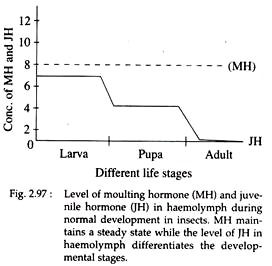
If prior to each moult a high level of JH is present then the resulting organism will be immature. If the JH is at a minimum, or completely absent, an adult will be formed. While with an intermediate level of JH the pupal period will be attained.
Therefore, from endocrinological point of view, the difference between moulting and metamorphosis is the concentration of JH in the haemolymph, prior to each moult in the immature stages. The moult which occurs without any juvenile hormone influence will produce metamorphosis leading to adult (Fig. 2.97).
5. Characteristics of Moulting Hormone (MH) in Insects:
A. Chemical Nature:
Moulting hormone of insects is called ecdysone. This is of two types: α-ecdysone and β-ecdysone. These are formed from cholesterol (Figs. 99 and 100)
B. Site of Synthesis:
Protothoracic glands.
C. Route of Transport:
Ecdysone, following its synthesis is transported to the haemolymph, via binding proteins to target tissues.
D. Control and Inactivation:
The titre of hormone is controlled by inactivating the hormone. MH is inactivated principally by formation of sulphate conjugates and to some extent glycoside derivatives (Fig. 2.98.).
E. Function:
It not only functions during moulting but also during embryonic and adult stages of insect life cycle.
6. Characteristics of Juvenile Hormone (JH) in Insects:
A. Chemical Nature:
JH of two types, JH-I and JH-II. They arise from two homo- isoprenoid and one normal isoprenoid units (Figs. 2.101, 2.102).
B. Site of Synthesis:
Corpora allata of brain.
C. Route of Transport:
Following synthesis it is secreted into the haemolymph and via haemolymph it is transported to the target cells. The lipid soluble JH is transported by haemolymph in association with a hydrophilic carrier protein. Besides transporting, the protein also has a role in protecting the hormone from degradative enzymes.
D. Control and Inactivation:
After performing its functions, the JH undergoes inactivation through the activities of carboxyl-esterase and epoxidehydrase enzymes.
E. Functions:
The most important effects of JH include its morphogenetic role in maintaining the larval (or nymphal) state in immature insects. It also regulates, entirely distinct processes connected with reproductive maturation and activity in adults.
